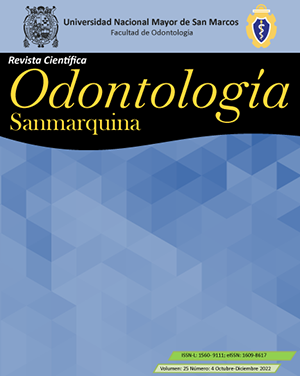Effectiveness in the recurrence rate of marsupialization, enucleation, and resection as treatment alternatives against odontogenic keratocyst
DOI:
https://doi.org/10.15381/os.v25i4.22710Keywords:
Resection, Marsupialization, Recurrence, Surgical enucleation, Odontogenic cystAbstract
The odontogenic keratocyst (OKC) has a high rate of recurrence that depends, in some cases, on the treatment chosen for the extraction of the lesion. This issue causes great concern among specialists. Given the various techniques, it is essential to compile current studies to provide reliable information and to be able to select the method that presents the least recurrence. For this reason, it was proposed to perform a literature review and determine the efficacy in terms of recurrence; regarding marsupialization, enucleation, and resection; as treatment options for patients with odontogenic keratocyst. We searched for scientific articles in the Pubmed, ScienceDirect and SciELO databases, published from 2012 to 2022, using the keywords: resection, marsupialization, recurrence, surgical enucleation, and odontogenic cysts. A total of 458 articles were found, 30 of which met the selection criteria, indicating that the total recurrence rate of OKC is between 4.5% and 45%; men between 4 and 96 years old are the most affected and the most frequent location is mandibular. Most authors state that the recurrence rate depends on the chosen surgical technique. Among the options, the most used are enucleation coupled with other methods and resection. It is concluded that marsupialization followed by simple enucleation presents a higher percentage of recurrence in OKC. The treatment with less recurrence is enucleation combined with another method. The bone resection technique appears to have low to zero percentage of recurrence in patients with OKC.
Downloads
Downloads
Published
Issue
Section
License
Copyright (c) 2022 Erika Fernanda Miguez Ortega, Ana Karina García Núñez, María Cristina Rockenbach Binz Ordoñez

This work is licensed under a Creative Commons Attribution 4.0 International License.
AUTHORS RETAIN THEIR RIGHTS:
a. Authors retain their trade mark rights and patent, and also on any process or procedure described in the article.
b. Authors retain their right to share, copy, distribute, perform and publicly communicate their article (eg, to place their article in an institutional repository or publish it in a book), with an acknowledgment of its initial publication in the Odontología Sanmarquina.
c. Authors retain theirs right to make a subsequent publication of their work, to use the article or any part thereof (eg a compilation of his papers, lecture notes, thesis, or a book), always indicating the source of publication (the originator of the work, journal, volume, number and date).






